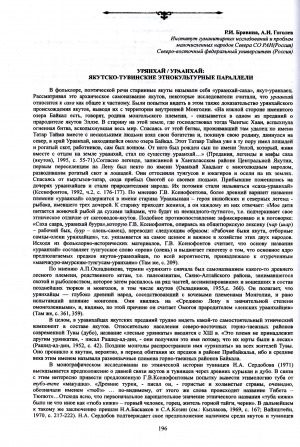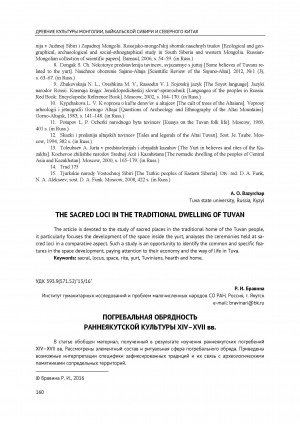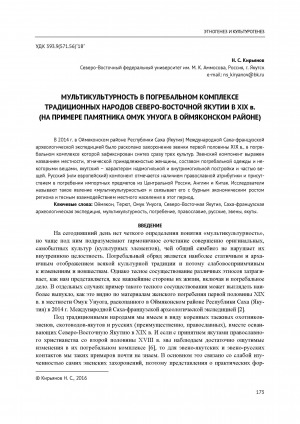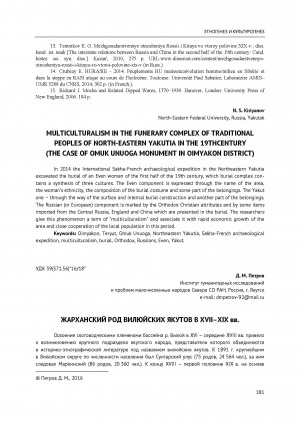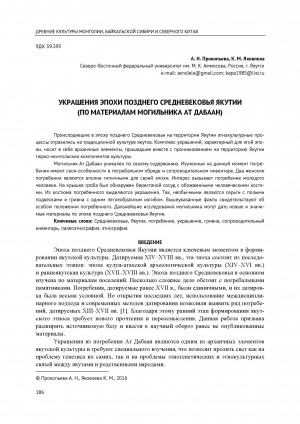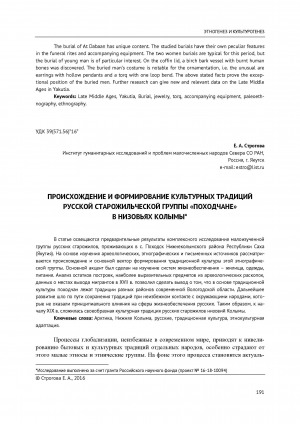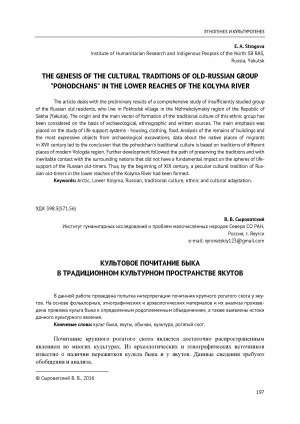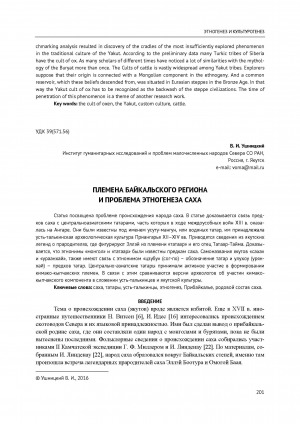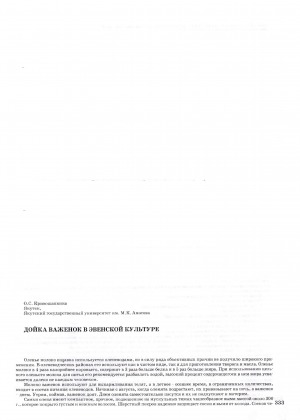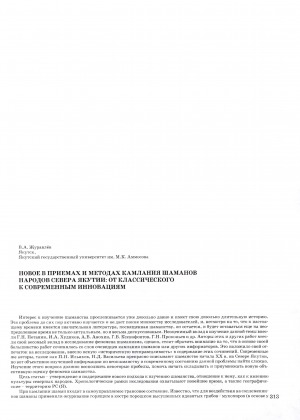Количество страниц: 4 с.
Бравина, Р. И. Урянхай / Ураанхай : якутско-тувинские этнокультурные параллели / Р. И. Бравина, А. И. Гоголев // Материалы V международной научной конференции "Древние культуры Монголии и Байкальской Сибири" (Кызыл, 15-19 сентября 2014 года). — Кызыл : Тувинский государственный университет, 2014. — Ч. 1. — С. 196-199.
Количество страниц: 6 с.
This paper aims to reconstruct the funeral rites of the early Yakut culture before arrival of Russians. It is based on the analysis of the burial composition and the ritual sphere of the funerary monuments of XIV–XVII centuries. The distinguishing feature of the burial composition of this time is a small depth of the burial pit, which on average is 0,48 cm deep. Box coffins are more common, and their parameters and structure are similar to those of the Hun coffins, with a similar external camera - grobovina, a special section for grave goods, and a lengthwise dividing wall in joint burials. The western orientation of the dead is associated with the traditional worldview about the geography of the world of the dead. The dead were buried horizontally lying on their back or in a crouched position lying on their side, sometimes with the head of the deceased resting on the saddle. The accompanying grave goods consist of household items, horse equipment, weapons and hunting tools, clothing and jewellery, as well as food for the journey in the form of lumps of a young horse. In At Dabaan III burial, there was discovered a pit with a dismembered horse next to the burial of the boy. The early Yakut burials are genetically related to the whole layer of ancient and medieval cultures of the Eurasian steppes in many respects. Their origin can be traced in archaeological complexes of Central Asia, Siberia and the Far East, where the funeral traditions of the medieval tribes of Baikal region and the Amur region are their nearest equivalents.
Бравина, Р. И. Погребальная обрядность раннеякутской культуры XIV-XVII вв.=Funeral rites of early Yakut culture of XVI–XVII centuries / Р. И. Бравина // Древние культуры Монголии, Байкальской Сибири и Северного Китая : материалы VII международной научной конференции, Красноярск, 3-7 октября 2016 г. — Красноярск : Сибирский федеральный университет, 2016. — Т. 2. — С. 160-165.
Количество страниц: 9 с.
In 2014 the International Sakha-French archaeological expedition in the Northeastern Yakutia excavated the burial of an Even woman of the first half of the 19th century, which burial complex contains a synthesis of three cultures. The Even component is expressed through the name of the area, the woman's ethnicity, the composition of the burial costume and some part of the belongings. The Yakut one - through the way of the surface and internal burial construction and another part of the belongings. The Russian (or European) component is marked by the Orthodox Christian attributes and by some items imported from the Central Russia, England and China which are presented in the burial. The researchers give this phenomenon a term of "multiculturalism" and associate it with rapid economic growth of the area and close cooperation of the local population in this period.
Кирьянов, Н. С. Мультикультурность в погребальном комплексе традиционных народов Северо-Восточной Якутии в XIX в.=Multiculturalism in the funerary complex of traditional peoples of North-Eastern Yakutia in the 19-th century : (на примере памятника Омук унуога в Оймяконском районе) / Н. С. Кирьянов // Древние культуры Монголии, Байкальской Сибири и Северного Китая : материалы VII международной научной конференции, Красноярск, 3-7 октября 2016 г. — Красноярск : Сибирский федеральный университет, 2016. — Т. 2. — С. 173-181.
Количество страниц: 5 с.
The development of the Vilyuy River basin by the cattle-breeding tribes in XVI–XVIII centuries led to the emergence of a large subsection of the Yakut people there, the representatives of which are united as the Vilyuy Yakuts in historical and ethnographic literature. By 1891, Suntarsky District (75 clans, 24 564 people.) had become the largest in terms of population in the Vilyuy region, followed by Markhinsky District (86 clans, 20 360 people.). By the end of XVIII – first half of XIX century, the following nasleg (villages) had been formed on the basis of the main clans: in Suntarsky Ulus (district) – I-III Zharkhanskies, I and II Bordonsky, Kangalassky, I and II Neryukteysky, I and II Nakharinsky, Khorinsky; in Markhinsky Ulus – I and II Zharkhansky, I-III Bordonsky, Kangalassky, Malzhegarsky, Odeysky, Asykaysky. This article focuses on the Zharhan clan of the Vilyuy Yakuts, which is the largest clan union in Yakutia. Members of this clan were carriers of the cult of the horse, which is reflected in the presence of burials with horse at their places of residence. This tradition links the clan with the tribes of the Ust-talkinsky archaeological culture of Baikal.
Петров, Д. М. Жарханский род Вилюйских якутов в XVII-XIX вв.=Clan of the Zharkhan of the Vilyuy Yakuts in the XVII–XIX centuries / Д. М. Петров // Древние культуры Монголии, Байкальской Сибири и Северного Китая : материалы VII международной научной конференции, Красноярск, 3-7 октября 2016 г. — Красноярск : Сибирский федеральный университет, 2016. — Т. 2. — С. 181-185.
Количество страниц: 6 с.
The Late Middle Ages period is a very important part of forming the Yakut ethnos. Ethnic and cultural processes of that time affected the traditional Yakut culture. The jewelry in this period have archaic elements that were brought to Yakutia by the Turk and Mongolian cultures. The burial of At Dabaan has unique content. The studied burials have their own peculiar features in the funeral rites and accompanying equipment. The two women burials are typical for this period, but the burial of young man is of particular interest. On the coffin lid, a birch bark vessel with burnt human bones was discovered. the buried man's costume is notable for the ornamentation, i.e. the unusual are earrings with hollow pendants and a torq with one loop bend. The above stated facts prove the exceptional position of the buried men. Further research can give new and relevant data on the Late Middle Ages in Yakutia.
Прокопьева, А. Н. Украшения позднего средневековья Якутии (по материалам могильника Ат Дабаан)=The late middle ages jewelry of Yakutia (based on burial of At Dabaan) / А. Н. Прокопьева, К. М. Яковлева // Древние культуры Монголии, Байкальской Сибири и Северного Китая : материалы VII международной научной конференции, Красноярск, 3-7 октября 2016 г. — Красноярск : Сибирский федеральный университет, 2016. — Т. 2. — С. 186-191.
Количество страниц: 7 с.
The article deals with the preliminary results of a comprehensive study of insufficiently studied group of the Russian old residents, who live in Pokhodsk village in the Nizhnekolymskiy region of the Republic of Sakha (Yakutia). The origin and the main vector of formation of the traditional culture of this ethnic group has been considered on the basis of archaeological, ethnographic and written sources. The main emphasis was placed on the study of life support systems - housing, clothing, food. Analysis of the remains of buildings and the most expressive objects from archaeological excavations, data about the native places of migrants in XVII century led to the conclusion that the pohodchan's traditional culture is based on traditions of different places of modern Vologda region. Further development followed the path of preserving the traditions and with inevitable contact with the surrounding nations that did not have a fundamental impact on the spheres of life-support of the Russian old-timers. Thus, by the beginning of XIX century, a peculiar cultural tradition of Russian old-timers in the lower reaches of the Kolyma River had been formed.
Строгова, Е. А. Происхождение и формирование культурных традиций русской старожильческой группы "походчане" в низовьях Колымы=The genesis of the cultural traditions of old-Russian group "pohodchans" in the lower reaches of the Kolyma River / Е. А. Строгова // Древние культуры Монголии, Байкальской Сибири и Северного Китая : материалы VII международной научной конференции, Красноярск, 3-7 октября 2016 г. — Красноярск : Сибирский федеральный университет, 2016. — Т. 2. — С. 191-197.
Количество страниц: 5 с.
An attempt of interpretation of the cattle of the Yakut is accomplished in this article. The main object of the research is to define the role of ox worship in the traditional spiritual space of Yakuts. The set problem required to collect and analyze the archeological, ethnographical and folk sources. A benchmarking analysis resulted in discovery of the cradles of the most insufficiently explored phenomenon in the traditional culture of the Yakut. According to the preliminary data many Turkic tribes of Siberia have the cult of ox. As many scholars of different times have noticed a lot of similarities with the mythology of the Buryat more than once. The Cults of cattle is vastly widespread among Yakut tribes. Explorers suppose that their origin is connected with a Mongolian component in the ethnogeny. And a common reservoir, which these beliefs descended from, was situated in Eurasian steppes in the Bronze Age. In that way the Yakut cult of ox has to be recognized as the backwash of the steppe civilizations. The time of penetration of this phenomenon is a theme of another research work.
Сыроватский, В. В. Культовое почитание быка в традиционном культурном пространстве якутов=Spiritual worship of ox in the traditional cultural space of the Yakut people / В. В. Сыроватский // Древние культуры Монголии, Байкальской Сибири и Северного Китая : материалы VII международной научной конференции, Красноярск, 3-7 октября 2016 г. — Красноярск : Сибирский федеральный университет, 2016. — Т. 2. — С. 197-201.
Количество страниц: 7 с.
The article discusses the origin of the Sakha people, and proves the connection between the Sakha ancestors with the Central Asian Tatars, some of which in the course of civil wars in the XIII century came to the Angara River. They were known by the name Usutu-Mangun or water Tatars, they belonged to Ust-Talkino archaeological culture of the Angara Region in the XII–XIV centuries. The information from the Yakut legends describing the forefathers features Elley from the tribe "tataar", and his father Tataar-Tyma It is proved that the ethnonyms “Mongol” and “Tataar” were known by the Sakha ancestors. The Endoethnonyms of Yakuts “Sakha” and “Uraanhay” also relate to the ethnonyms “Zubu” (sog-po), the names referred to the Tatars and Uluhou (Uriangkhai) - ancestors of the Tatars. The Central Asian Tatars took an active part in shaping the Kimak-Kipchak tribes. That is why the versions of archeologist about the participation of the Kimak-Kipchaks in formation of Ust-Talkintses and the Yakut culture are compared in the article. Thus, the beginning of the ethnogenesis of Sakha ancestors is associated with the region of Lake Baikal, where the Turkic ancestors of the Sakha contacted with the Mongol tribes.
Ушницкий, В. И. Племена Байкальского региона и проблема этногенеза саха=The tribes of Baikal region and the ethnogeny of the Sakha / В. И. Ушницкий // Древние культуры Монголии, Байкальской Сибири и Северного Китая : материалы VII международной научной конференции, Красноярск, 3-7 октября 2016 г. — Красноярск : Сибирский федеральный университет, 2016. — Т. 2. — С. 201-207.
Ответственность: Алексеев Анатолий Афанасьевич (Научный руководитель)
Количество страниц: 2 с.
- Национальная культура, обряды, праздники коренных малочисленных народов Севера > Традиционные обряды, праздники, искусство коренных малочисленных народов Якутии > Эвены,
- Общественные науки. Образование > Этнография. Обычаи. Жизнь народа. Нравы,
- НАУКА ЯКУТИИ > ОБЩЕСТВЕННЫЕ НАУКИ > Этнография. Обычаи. Жизнь народа. Нравы,
- КНИГАКАН > Все народы > Эвены (тунгусо-маньчжурская группа языков) > Этнография. Фольклор.
Кривошапкина, О. С. Дойка важенок в эвенской культуре / О. С. Кривошапкина // Истоки, формирование и развитие Евразийской поликультурности. Культуры и общества Северной Азии в историческом прошлом и современности : материалы I(XLV) Российской с международным участием археологической и этнографической конференции студентов и молодых ученых (РАЭСК-XLV) 12-16 апреля 2005 г., Иркутск. — Иркутск: Радиан, 2005. — С. 333-334.
Ответственность: Горохов Семен Николаевич (Научный руководитель)
Количество страниц: 4 с.
Журавлев, В. А. Новое в приемах и методах камлания шаманов народов Севера Якутии : от классического к современным инновациям / В. А. Журавлев // Истоки, формирование и развитие Евразийской поликультурности. Культуры и общества Северной Азии в историческом прошлом и современности : материалы I(XLV) Российской с международным участием археологической и этнографической конференции студентов и молодых ученых (РАЭСК-XLV) 12-16 апреля 2005 г., Иркутск. — Иркутск: Радиан, 2005. — С. 313-315.
